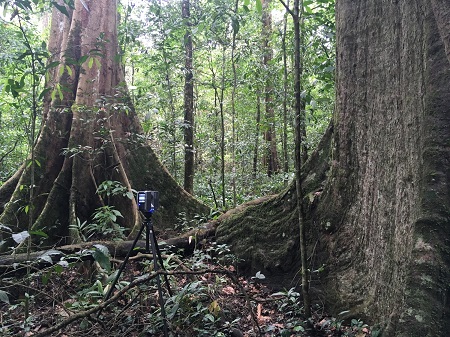In collaboration with The University of the South Pacific, a research team led by the University of Goettingen (Germany) has analysed the complexity of forest structure in Fiji, and around the world.

An international research team led by the University of Goettingen has investigated the variety of structures that can be found in the world’s forests, as well as the factors that explain this diversity. The results have recently been published in Nature Communications, a top-ranking scientific journal.
Professor Hans Juergen Boehmer, former Head of School of USP´s School of Geography, Earth Science & Environment and co-author of the study, explains that understanding the three-dimensional structure of forests is important because it influences processes of gas and energy exchange with the atmosphere, whilst also providing habitats for numerous species.
“As primeval forests were in the focus of this research, we used forest stands in Savura that appear to have a structure relatively unchanged by human impact.” Primeval forests are of great importance for biodiversity and global carbon and water cycling.
Professor Boehmer was USP´s co-ordinator of the exchange program with the University of Goettingen´s Section for Tropical and Subtropical Agriculture and Forestry (SeTSAF) which started in 2014 and was funded by the German Academic Exchange Service (DAAD). In the following 5 years, several researchers from both universities participated in the program, establishing a fruitful collaboration between the institutions.
The researchers investigated the structure of primeval forests in different climate zones. To achieve this, the team spent two years travelling to remote primeval forest areas around the world to record the structure of the forests with the help of 3D laser scanners (see photo 1). A laser scanner captures the environment with the help of a laser beam and thus builds a 3D representation of the forest. This allows important metrics to be calculated to describe the structure.
They found that the global variability of forest structures can be explained to a large extent by the amount of precipitation and thus by the availability of water in the different ecosystems. Based on these findings and with the help of climate data, they were able to create maps of the world’s forests showing the global variability of structural complexity.
“A long-term goal of our research is to better understand how human influence and climate change affect the forest, its structure and the processes linked to it. The structure of primeval forests is an important reference point for this,” says first author Dr Martin Ehbrecht from the University of Goettingen.
A particular focus here is the question of how changes in precipitation patterns due to climate change affect the structure of forests. “The importance of water for the formation of complex forest structures can be explained by various interacting mechanisms,” says Ehbrecht. “The availability of water is an important driver of the diversity of tree species. The more tree species a forest holds, the more pronounced is the coexistence of different crown shapes and sizes of trees. This means that the space available for the crowns of trees can often be utilised more efficiently in species-rich forests, which makes the forest structure more complex.
There is more related research going on in Fiji´s forests, Professor Boehmer says. “We have applied the 3D laser scanner for quantifying the impact of invasive alien ivory cane palm (Pinanga coronata) in forests throughout Colo-i-Suva and Savura (see photo 2), and to get a clearer picture to what extent this dangerous invader is changing forest structure in native and planted forests in the area. We hope to see the results of this research published in the course of 2021.”
Original publication:Martin Ehbrecht et al., Global patterns and climatic controls of forest structural complexity. Nature Communications (2021). Doi: https://doi.org/10.1038/s41467-020-20767-z
University of Goettingen Press Release:https://www.uni-goettingen.de/en/3240.html?id=6161
Contact:
Hans Juergen Boehmer, PhD
Currently:
Visiting Professor of Biogeography
Institute of Geography
University of Jena
Loebdergraben 32
GERMANY
+49-3641-948858
hans.juergen.boehmer@uni-jena.de
http://orcid.org/0000-0002-9176-4836
www.researchgate.net/profile/Hans_Juergen_Boehmer
– Editor, Endangered Species Research (ESR)
– IUFRO Taskforce ‘Monitoring Global Tree Mortality Patterns and Trends’
– IUFRO Working Group 4.02.01 ‘Resource data for the tropics’